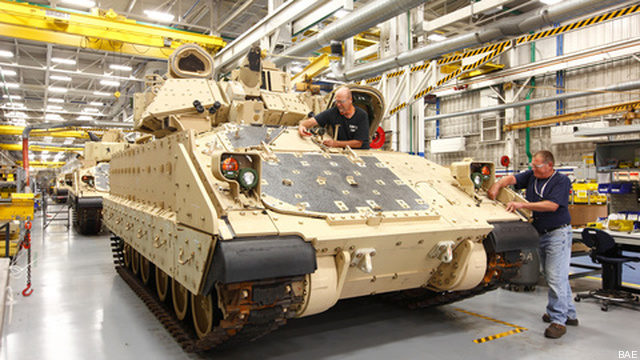HASC Throws General Dynamics Little Bone On AMPV
Posted on

A variant of BAE System’s tracked M2 Bradley, shown here, is the odds-on favorite to beat General Dynamics’ wheeled Stryker for the Army’s Armored Multi-Purpose Vehicle contract.
This morning, a House Armed Services subcommittee passed its markup of its part of the annual defense bill that would — among many other things — freeze some funding for the Army’s Armored Multi-Purpose Vehicle Program. AMPV is the service’s biggest weapons program left standing after sequestration’s budget cuts, and contractor General Dynamics had protested the competition was unfair and pledged to take its case to Congress. So the company hailed the legislative language in a public statement as soon as it was made public yesterday. But, on closer examination, while, the subcommittee threw GD a bone, it’s not one with much meat on it.
“It means nothing,” one Hill staffer said. “Only a 20 percent fence and a cupcake report for the Army to write.” The language that the HASC tactical air and land forces subcommittee passed today would allow the Army to spend 80 percent of the funding allocated for the Armored Multi-Purpose Vehicle. To get the last 20 percent, the Army just has to submit a report on the program by March 1st, 2015.
The report requirement does have two interesting wrinkles — but they mainly illustrate how limited General Dynamics’ ambitions have become. First, while the current AMPV program will replace vulnerable Vietnam-vintage M113 armored vehicles now serving with tank brigades, the subcommittee also tells the Army to study replacing M113s in other units, especially higher echelon formations more removed from frontline fighting. Second, when it comes to the Armored Brigade Combat Teams themselves, the subcommittee only asks specifically about one of the AMPV’s five missions, the “medical evacuation” variant, a kind of armored ambulance. Specifically, the subcommittee wants to see if this one mission could be performed by a wheeled vehicle.
Why do wheels matter? At one point, General Dynamics was trying to build a tracked candidate for AMPV, but that never materialized. So GD is stuck offering its eight-wheel-drive Stryker, which generally costs less to operate than tracked vehicles but can’t cross certain terrain as well, especially soft ground. A big part of General Dynamics’ protest — predictably rejected by the Army — was the argument that the mobility requirements for AMPV effectively ruled out any wheeled vehicle, which would mean an automatic win for BAE System’s tracked Bradley. (Both Strykers and Bradleys have solid combat records in Iraq).
“This language demonstrates that the subcommittee recognizes the AMPV acquisition strategy needs to be improved,” General Dynamics declared yesterday. Maybe so, but what it also declares is that General Dynamics and its backers in Congress may be giving up on ever getting the whole AMPV contract and have started focusing on splitting the buy. Under such a “mixed fleet” plan, the Army would buy tracked BAE Bradleys for the roles that require the most mobility but buy Strykers for less demanding missions, like the armored ambulance and support vehicles not assigned to combat brigades.
BAE’s statement on the matter says “the House’s language clearly dismisses the notion of a split buy.” But as I read the bill, it’s silent on the question, one way or another.
So would the Army consider a split buy? Perhaps. But it’s very unlikely to want a mix of tracked and wheeled armored vehicles within the armored brigade combat team: The mobility differences would hinder cross-country maneuver, the mechanical differences would increase maintenance demands.
That said, commanders might be content with lower-mobility vehicles serving in rear-echelon units outside the armored brigades. But given the Army’s budgetary agonies, the service is not going to start buying new vehicles for those lower-priority units any time soon.
Subscribe to our newsletter
Promotions, new products and sales. Directly to your inbox.
